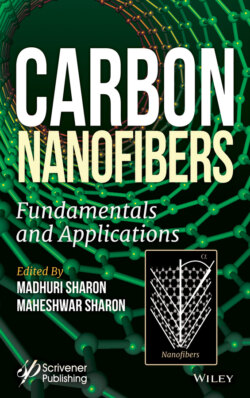Читать книгу Carbon Nanofibers - Группа авторов - Страница 82
3.6 Synthesis of Carbon Nanofiber (CNF) Using Nanocatalysts
ОглавлениеDifferent methods, such as incipient-wetness impregnation, ion exchange, organometallic grafting, electron beam evaporation, and deposition/precipitation followed by reduction, are used to prepare noble metal nanoparticles supported on carbon fibrous materials. In all cases, a delicate optimization of carbon surface chemistry is needed to achieve optimal interaction between the support and metal precursor.
Due to their unique nature, carbon nanofibers are considered as exciting supports for noble metal nanoparticles. Indeed, hollow nanotube cavities can be used to control a particle size and shape. High metal dispersion was obtained on CNTs even if the specific surface area of the support was only 25 m2/g. Nanotubes can be filled by metals during the arc-discharge synthesis in the presence of metals or through opening and filling the tubes by a metal precursor followed by reduction. It is also possible to remove unwanted metal particles from the outside surface of CNTs [39]. The process took place via reduction of [PdCl4]2~ anions and simultaneous encapsulation of Pd nanoparticles in CNTs during rolling of graphene sheets from the anode.
Cu particles supported on different types (fishbone, platelet, ribbon, and tubular) of CNFs were deposited from aqueous salt solutions [40]. If Cu nanoparticles were located on the edge sites of nanofibers, they adopted a thin faceted morphology, indicating a strong metal-support interaction. The particles formed in such a way were very stable with respect to sintering. However, the particles tended to acquire a globular geometry if the copper was supported on AC or the basal planes of graphite, showing a very weak interaction with the support. Thus, the fishbone and platelet CNFs were the best supports to provide small particles with a narrow size distribution. A precursor salt and carbon surface functionality also affect the particle size distribution and stability.
Supported Cu nanoparticles (<10 nm) were prepared using CNFs with a diameter ranging from 100 nm. Carbon nanofibers were impregnated with a copper salt solution, dried and treated by H2 (773 K). The electronic properties of the nanoparticles differed considerably from those of bulk copper. It was noticed that the size of Cu particles was dependent on the size of CNFs: the smaller the fiber diameter, the smaller the Cu nanoparticle size obtained. However, the nanoparticles were not strongly attached to the support and could be detached by ultrasonic treatment.
The Pd nanoparticles supported on CNFs exhibited a comparable activity in hydrogenation of nitrobenzene to aniline and increased activity in hydrogenation of C=C bond of cinnamaldehyde with respect to the commercial Pd catalyst based on AC. An important advantage of the CNF support is that surface area, size of fibrils, as well as mechanical strength can be controlled and mass transfer limitation can be decreased, because of the absence of micropores. A change of electronic properties of Pd particles provided by interaction with CNFs resulted in a change of their catalytic properties in 1,3-butadiene hydrogenation to butanes. An increase of the Pd2+ fraction in the catalysts decreases the activity and selectivity.
Pd supported on the fishbone-type CNFs was studied in hydrogen storage. The hydrogen loading of 1.5 wt% was reached at 10 MPa of H2 pressure for nanofibers with specific surface area of 400 m2/g and Pd:C mole ratio close to 1. Hydrogen of 3.1 wt% stored was reported for the 4.1 wt% Pd/MWNT material. However, all these values are well below the 6.5 wt% benchmark set by the U.S. Department of Energy for such kinds of materials.
Carbon nanofibers (CNFs) are hydrophobic, generally without significant functional groups. The diameter of a CNF ranges between 50 nm and 200 nm and that of the carbon nanotubes is usually less than 100 nm. Several methods have been used in the synthesis of CNF.
